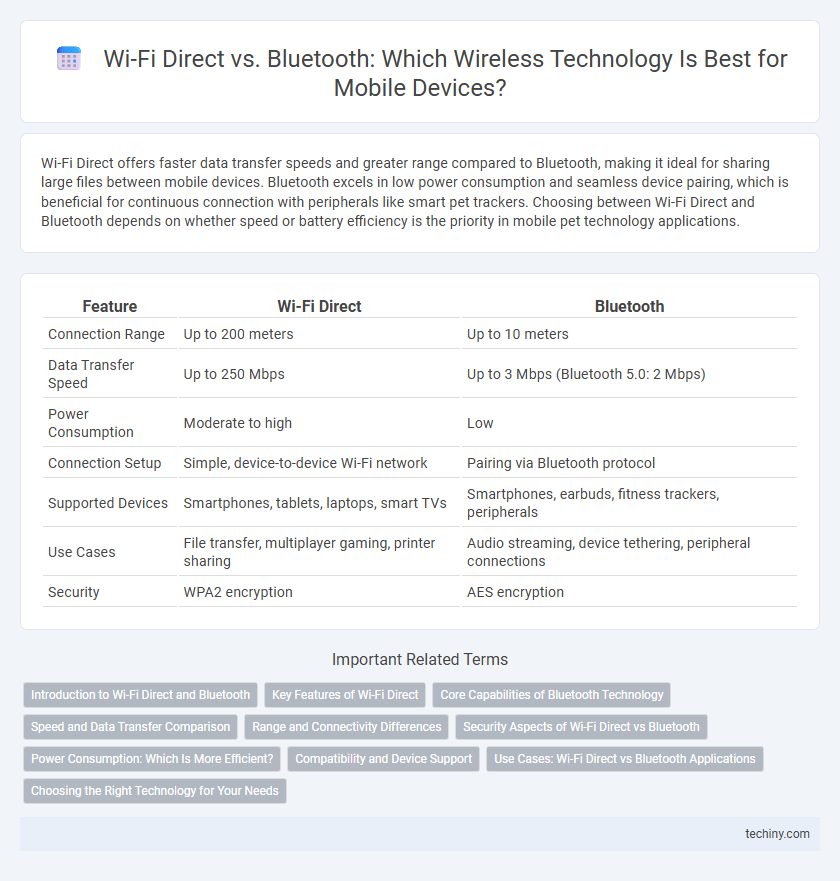Wi-Fi Direct offers faster data transfer speeds and greater range compared to Bluetooth, making it ideal for sharing large files between mobile devices. Bluetooth excels in low power consumption and seamless device pairing, which is beneficial for continuous connection with peripherals like smart pet trackers. Choosing between Wi-Fi Direct and Bluetooth depends on whether speed or battery efficiency is the priority in mobile pet technology applications.
Table of Comparison
| Feature | Wi-Fi Direct | Bluetooth |
|---|---|---|
| Connection Range | Up to 200 meters | Up to 10 meters |
| Data Transfer Speed | Up to 250 Mbps | Up to 3 Mbps (Bluetooth 5.0: 2 Mbps) |
| Power Consumption | Moderate to high | Low |
| Connection Setup | Simple, device-to-device Wi-Fi network | Pairing via Bluetooth protocol |
| Supported Devices | Smartphones, tablets, laptops, smart TVs | Smartphones, earbuds, fitness trackers, peripherals |
| Use Cases | File transfer, multiplayer gaming, printer sharing | Audio streaming, device tethering, peripheral connections |
| Security | WPA2 encryption | AES encryption |
Introduction to Wi-Fi Direct and Bluetooth
Wi-Fi Direct enables devices to connect wirelessly without a traditional Wi-Fi network, offering higher speeds and longer range compared to Bluetooth. Bluetooth is designed for short-range communication between devices, optimizing power efficiency and ease of pairing for peripherals like headphones and fitness trackers. Both technologies facilitate device communication but are tailored for distinct use cases based on speed, range, and power consumption.
Key Features of Wi-Fi Direct
Wi-Fi Direct enables peer-to-peer wireless connections without requiring a traditional hotspot, offering faster data transfer speeds up to 250 Mbps compared to Bluetooth's typical 3 Mbps. It supports simultaneous connections to multiple devices, ideal for streaming high-definition media and file sharing among smartphones, tablets, and laptops. Wi-Fi Direct also provides enhanced security protocols, including WPA2 encryption, ensuring a more secure communication channel than Bluetooth's standard encryption methods.
Core Capabilities of Bluetooth Technology
Bluetooth technology offers seamless device connectivity with low power consumption and reliable data transfer over short distances, typically up to 100 meters. It supports multiple device pairing, enabling hands-free communication, audio streaming, and IoT integration with robust security protocols like AES encryption. Bluetooth's adaptive frequency hopping reduces interference, ensuring stable connections in crowded wireless environments.
Speed and Data Transfer Comparison
Wi-Fi Direct offers significantly faster data transfer speeds, reaching up to 250 Mbps, compared to Bluetooth's typical maximum of 3 Mbps with its latest versions. This speed advantage allows Wi-Fi Direct to handle larger file transfers and high-bandwidth applications more efficiently than Bluetooth. Despite Bluetooth's lower speed, it remains popular for low-energy, short-range connections due to its ease of use and widespread device compatibility.
Range and Connectivity Differences
Wi-Fi Direct offers a significantly longer range of up to 200 meters compared to Bluetooth's typical range of 10 meters, enabling more flexible device connectivity in larger spaces. The technology supports faster data transfer speeds, reaching up to 250 Mbps, which surpasses Bluetooth's maximum of around 3 Mbps, enhancing multimedia sharing and large file transfers. Wi-Fi Direct also allows multiple device connections simultaneously, whereas Bluetooth generally supports fewer connections, impacting the versatility of networked devices.
Security Aspects of Wi-Fi Direct vs Bluetooth
Wi-Fi Direct offers enhanced security features compared to Bluetooth, utilizing WPA2 encryption protocols that provide robust protection against unauthorized access and eavesdropping. Bluetooth relies on pairing mechanisms with varying security levels, such as Secure Simple Pairing (SSP), but remains more vulnerable to attacks like Bluejacking and Bluesnarfing. Wi-Fi Direct's use of stronger encryption standards and its ability to create private network connections make it a more secure option for peer-to-peer wireless communication.
Power Consumption: Which Is More Efficient?
Wi-Fi Direct consumes more power than Bluetooth due to its higher data transfer rates and longer range capabilities, making it less energy-efficient for continuous communication. Bluetooth, especially Bluetooth Low Energy (BLE), is designed for minimal power use, ideal for battery-sensitive devices and short-range connections. For applications prioritizing power efficiency, Bluetooth remains the superior choice over Wi-Fi Direct.
Compatibility and Device Support
Wi-Fi Direct offers broader compatibility across various devices, including smartphones, tablets, laptops, and smart TVs, supporting high-speed data transfer without requiring a traditional Wi-Fi network. Bluetooth is widely supported in nearly all mobile devices and peripherals, such as headphones, wearables, and speakers, but typically provides lower data transfer speeds and shorter range compared to Wi-Fi Direct. Device support for Wi-Fi Direct is increasing, especially in newer models with Wi-Fi 5 or 6, while Bluetooth remains a universal standard for seamless, low-power connectivity across diverse device ecosystems.
Use Cases: Wi-Fi Direct vs Bluetooth Applications
Wi-Fi Direct supports high-speed file transfers, screen sharing, and multiplayer gaming, making it ideal for bandwidth-intensive applications. Bluetooth excels in low-power, short-range uses such as wireless headphones, fitness trackers, and smart home devices. Both technologies complement each other by addressing distinct connectivity needs across mobile technology ecosystems.
Choosing the Right Technology for Your Needs
Wi-Fi Direct offers faster data transfer speeds and greater range compared to Bluetooth, making it ideal for high-bandwidth applications like streaming and large file sharing. Bluetooth excels in power efficiency and ease of use for connecting peripherals such as headphones, keyboards, and fitness trackers. Selecting between Wi-Fi Direct and Bluetooth depends on your specific requirements for speed, range, and device compatibility within mobile technology.
Wi-Fi Direct vs Bluetooth Infographic

 techiny.com
techiny.com